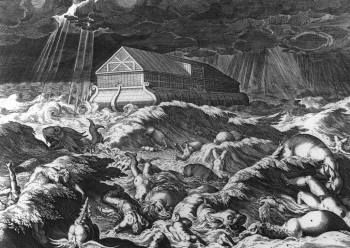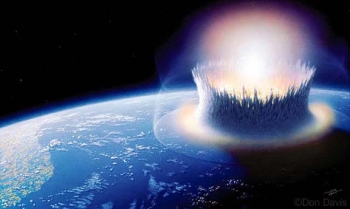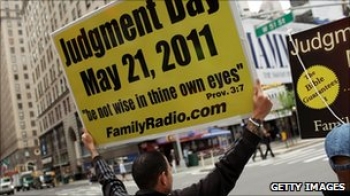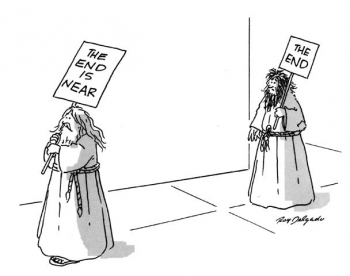If you're reading this, it means that the Apocalypse did not arrive on May 21st, 2011 as predicted by the evangelical preacher Harold Camping. Doomsday scenarios are an interesting phenomenon, particularly due to their general scope since they also exist outside of formal religious belief systems. I'll investigate the origins of this sociological (I’ll treat it as such) phenomenon, its reasons and possible benefits.
End of the world myths accompany all cultures, in tandem with myths of creation. Aside from the great flood of the Sumer or the Apocalypse of the Christians, we see the seeds of our collective doom everywhere. Consider the recent popular myth concerning the Large Hadron Collider activation. The empirical fact of micro black holes appearing as a side effect of LHC’s functioning stimulated our collective doomsday confabulation creativity. This myth had spread at a viral rate as the date of LHC's going online approached.
This was just a fitting recent example of the more universal human trend of compulsively conjuring doomsday scenarios left right and centre. Our track record includes the end of the world coming at the hands of the Philistines, barbarians or aliens; floods, plague, lethal viruses and asteroids; future intelligent robots that will rise against us, and if all predictions fail there’s certainly the reliable scenario of a nuclear holocaust. In this list, I would certainly grant more validity to self inflicted causes of destruction, but that's another story.
So it is undeniable - the elephant is in the room. But where does this compulsive and hysterical tendency of fatal scenarios come from? Why do we notoriously stigmatize our collective consciousness with inevitable eschatological events? I tend to be better at asking questions than providing answers, but consider the following:
We cannot escape noticing a cyclical nature to all natural phenomena. From the periodic oscillations at the Planck scale (the smallest scale we can talk meaningfully about) to our own pulse, breath and heartbeat; days, seasons and recorded cycles appearing on the celestial sphere. In cyclical cosmologies this pattern continues consistently to encompass the nature of the entire universe as well. In short, there's a hierarchy of cycles.
Periodic and cyclical phenomena even in linear cosmologies have significant milestones - first day of Spring, coming of age for a teenager, graduation, a baby’s first words or steps etc. We endow those milestones with significance, and celebrate them through a wonderful plethora of rites of passage.
Death is also a milestone. What's more, each of us in a more or less vivid way is aware of that special milestone awaiting us in some uncertain future. Now, I conjecture that social phenomena and eventually cultural tradition are tell tale signs of our personal relationship with our own mortality.
The awareness of each individual of their own impermanence manifests in the collective expectation of an analogous special milestone for the whole world at large. This occurs subconsciously, as we intuitively draw an analogy from lower level cycles and their character, to larger scale cycles - the unconscious assumption springs from our prodigious capacity for pattern recognition and hence noticing the self similar character of all nature's cycles.
It would be interesting to perform a comparative study across cultures and religions between individual and cosmological eschatology - I certainly believe there's a connection of character between the two.
Those ‘end of days' scenarios, play an important role in taming our anxieties concerning death. They serve as a reminder, a memento mori (for centuries the interior walls of Catholic temples have been covered with scenes of the Apocalypse), of our own impermanence. Buddhism encourages meditating on three root reflections; that death is definite, that it's time of arrival is uncertain, and the attitude nourished through the first two is the best to have at the time of death.
There's plenty of evidence which shows that this constant awareness of our mortality nourishes active compassion and inner peace. Making the fact of our impermanence more tangible and vivid and subsequently realizing how fragile and ephemeral life is contributes to valuing the present and those beings whom we have been privileged to share this present with.
So next time you see the crazy hobo brandishing the sign 'The end is nigh', or see an advert for the latest Hollywood blockbuster entitled along the lines of 'Armageddon' or '2012' reflect on the value of those eccentric reminders.


















